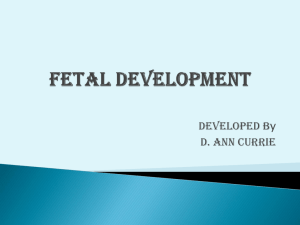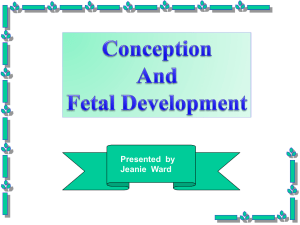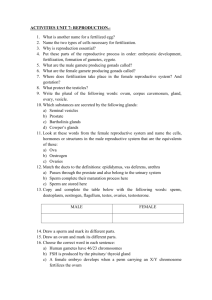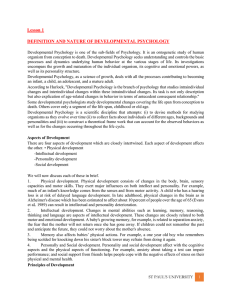Conception and Fetal Development
advertisement
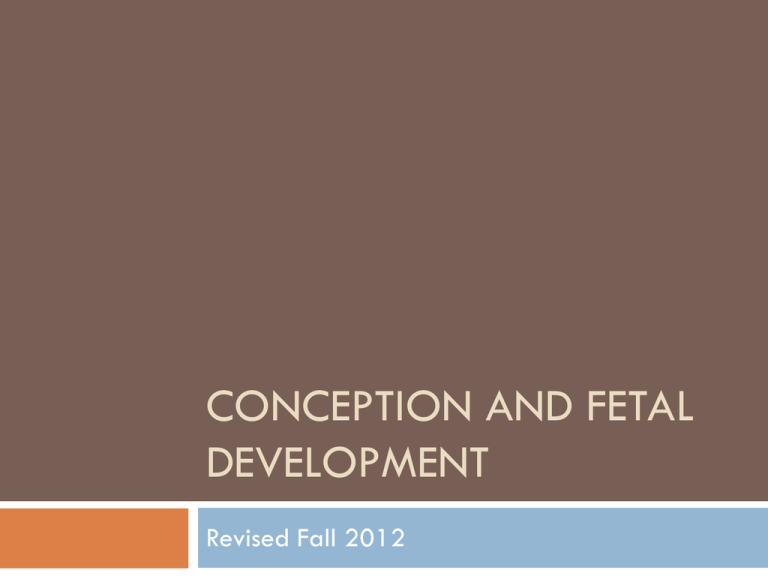
CONCEPTION AND FETAL DEVELOPMENT Revised Fall 2012 HOW DOES THE FEMALE BODY PREPARE FOR CONCEPTION? Describe the process of maturation of an ovum Menstrual Cycle Varies every 28 - 35 days The time between ovulation and menstruation is relatively constant (14 days). Luteal phase. The variable is from menses to ovulation. It can not be predicted, the Follicular phase. Affected by various physical and emotional factors Maturation of the Ovum Ovarian Cycle Follicular Phase- Development of the graafian follicle (ovum) Ovulatory Phase- about 2 days before ovulation Luteal Phase- Formation of corpus luteum HOW WILL THE PATIENT KNOW THAT SHE IS OVULATING? Signs and Symptoms of Ovulation 1. Body temperature increase 2. Mittelshmerz 3. Cervical mucus changes Increase in amount Becomes thin, watery, and clear Ferning Stretchable: spinnbarkheit Alkaline WHAT HAPPENS TO THE CORPUS LETEUM OF I DO NOT GET PREGNANT? WHAT HAPPENS TO THE CORPUS LUTEUM IF I BECOME PREGNANT? Endometrial Cycle The uterine endometrium repsonds to ovarian hormones and goes through the phases in building up the lining of the uterus in preparation for implantation Proliferative Secretory Menstural Hormonal Cycle FSH- Follicle stimulating hormone Begins LH- Luteinizing hormone Assists growth and maturation of the graafian follicle in continued growth of the graafian follicle Estrogen Responsible for proliferation of endometrium Progesterone “Pro gestation”. The corpus luteum produces progesterone so the endometrium won’t slough off Conception Maturation of ovum and sperm cells Pregnancy comes about from the union of a female germ cell, ovum with a male germ cell, the spermatozoon Conception One ovum per month is discharged from the ovary. It is transported into the fallopian tube where it begins its journey through the tube in search of the sperm. Viable for 12-24 hours Fertalization When intercourse occurs, millions of sperm travel in search of an ova. During travel through the female reproductive system, capacitation occurs Fertilization As the sperm swarm around the ova, the Acromosome caps of sperm release zona digesting enzymes WHY IS THE NUMBER OF SPERM SO IMPORTANT IF ONLY ONE SPERM ENTERS THE EGG? Fertilization Distal portion of the fallopian tube Only one sperm penetrates ova Each contributes 23 chromosomes Sex of baby determined at this time PRE-EMBRYONIC DEVELOPMENT Fertilized ovum begins its travel to the uterus Cellular Multiplication Morula eventually forms a fluid filled cavity within the cell mass. Inner solid cell mass is called the blastocyst Outer cell mass that surrounds the cavity is called the trophobast Trophoblast Outer layer of cells Blastocyst Inner cell mass Placenta Chorion Fetus Amnion Implantation Germ Layers Ectoderm Mesoderm Endoderm Development Periods Stage 1 – pre-embryonic weeks 1-2 Stage 2 -- embryonic weeks 3-8 period of ORGANOGENESIS Stage 3 -- fetal weeks 9 - 40 Embryonic Period Weeks 4-8 Week 4 anterior end of neural tube closes to form the brain and the posterior end closes to form the spinal cord Heart begins to beat Eyes appear Limb Buds for arms and legs CR = 4 mm Week 5 Head grows larger Hand and feet plates develop Facial features begin to develop CR = 8 mm. Week 6 Fetal circulation is established Chambers form in the heart Upper lip and palate start fusing Eyes move to front of face Fingers are webbed External ear develops Week 7 Eyelids start to form Fingers develop; elbows visible Diaphragm separates abdomen from chest Bronchi develop Arms and legs move Week 8 Fingers and toes distinct Skeletal ossification begins Testes and ovaries are distinguishable Heart has four chambers Circulation through umbilical cord occurs *** ALL essential external and internal structures are present and now will continue to grow The patient tells the nurse that she is worried that the baby may have some defect because she was on antibiotics and other cold medication during the first week after intercourse/conception What is happening during the first week after conception that would assist the nurse in answering her question? Fetal Period Weeks 9-40 Weeks 9-12 Head size increases Face is well formed Nails appear Eyelids appear and close and fuse shut Kidneys excrete urine Intestines are forming; peristalsis begins Heartbeat can be heard via ultrasound Tooth buds appear for the baby teeth Weeks 13-16 Lips form, facial contour develops Ossification of bone begins Meconium begins to form in the intestines Hair present on scalp Sex can be determined visually Weeks 17-20 Hair abundant on head Lanugo covers the body Vernix begins to form Myelination of spinal cord begins Suck and swallow begin Quickening occurs ~ 18 weeks Weeks 21-24 Respiratory movement with air sacs formed Surfactant production begins ~ 24 weeks Brain appears mature Eyebrows and eyelashes can be seen Reacts to sudden noise with active movement Weeks 25-28 Eyelids open and close Capillaries proliferate around the lungs’ alveoli making gas exchange possible Skin has wrinkled red appearance Rapid brain development Weeks 29-32 Subcutaneous fat forms Testes start descending Fingernails and toenails are complete Bones are fully developed, but still soft and pliable Weeks 33-40 Limbs start to flex Muscle tone is developed Lanugo disappears Body begins to store fat Maternal antibodies transfer to the fetus Exhibits sleep and awake patterns Answer this…… The fetal nervous system is formed by the germ layer known as the: a. ectoderm b. mesoderm c. entoderm d. endoderm AUXILLARY STRUCTURES Placenta Fetal Membranes Functions of the Placenta Fetal Respirations Fetal Nutrition Endocrine Functions Elimination of Wastes Barrier against certain substances Amnion Smooth, glistening membrane known as the Amnion is the lining of a fluid filled space that develops around the embryo Functions of Amniotic Fluid Keeps the fetus at an even temperature Cushions the fetus against possible injury Provides place for the fetus to move easily and grow symmetrically Fetus drinks the fluid Chorion Thick membrane with finger-like projections called chorionic villi. Chorionic villi contain blood vessels that are main connection with mother. Chorionic villi produce human chorionic gonadotropin (HCG) Merges with the decidua basalis to form the PLACENTA. Umbilical Cord Body stalk that attaches the embryo to the yolk sac Contains blood vessels that extend into the chorionic villi Protected by wharton’s jelly Teratogens Risk factors such as environmental substances Smoking Alcohol Drugs Viruses Occupational hazards During what period of time is the baby most susceptible to damage from teratogens? Review Describe the components of the process of fertilization. Ovum released into fallopian tube—viable for 24 hr. Sperm deposited into vagina—viable for 48 to 72 hr (highly fertile for 24 hr). Sperm must undergo capacitation and acrosomal reaction. Sperm penetration causes a chemical reaction that blocks more sperm penetration. Fertilization occurs in the distal end of the fallopian tube. Sperm enters ovum. The nuclei of the ovum and sperm unite and become a diploid zygote. Review How can knowledge of the normal fertilization process assist in helping couples conceive? Review How can knowing the gestational age of the fetus help in assessment for the potential effects of a teratogen?
